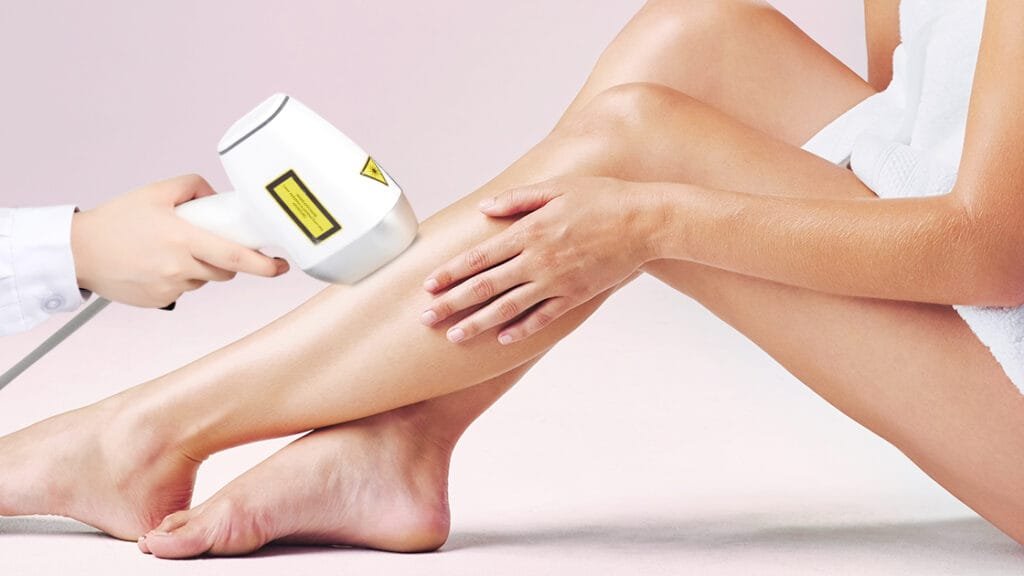1. Introduction to Laser Hair Removal and Its Popularity
The beauty industry has witnessed a remarkable transformation over the past decade, with laser hair removal emerging as one of the most sought-after cosmetic treatments worldwide. This revolutionary procedure has fundamentally changed how people approach unwanted hair management, offering a long-term solution that goes far beyond traditional methods like shaving, waxing, or plucking.
1.1 What Is Laser Hair Removal?
Épilation au laser represents a sophisticated medical aesthetic procedure that utilizes concentrated light energy to permanently reduce unwanted hair growth. The treatment employs selective photothermolysis, a principle where specific wavelengths of light target melanin chromophores within hair follicles. During the procedure, laser energy penetrates the dermal layer, heating the follicular unit to temperatures sufficient to denature proteins responsible for hair growth, ultimately leading to follicular destruction and permanent hair reduction.
1.2 Why Is Laser Hair Removal So Popular?
The exponential growth in laser hair removal popularity stems from its unparalleled efficacy and convenience compared to conventional hair removal methods. Unlike temporary solutions that require frequent maintenance, laser treatments offer long-lasting results, with many patients experiencing permanent hair reduction after completing their treatment series. The procedure’s precision allows practitioners to target unwanted hair while preserving surrounding tissue integrity, making it suitable for virtually any body area including facial regions, underarms, legs, bikini areas, and back.
1.3 Potential Risks of Laser Hair Removal: Is Burning a Concern?
While laser hair removal maintains an excellent safety profile when performed correctly, potential complications including burns, scarring, and permanent skin discoloration can occur, though burns are not common. Understanding these risks becomes crucial for both practitioners and patients seeking optimal treatment outcomes. Thermal injury represents the most serious potential complication, occurring when excessive laser energy overwhelms the skin’s natural cooling mechanisms, leading to epidermal and dermal damage that may result in blistering, hyperpigmentation, or permanent scarring.
2. Understanding How Laser Hair Removal Works
To comprehend burn prevention strategies, one must first understand the fundamental mechanisms underlying laser hair removal technology. This knowledge forms the foundation for safe treatment protocols and helps explain why certain factors increase burn risk.
2.1 The Science Behind Laser Hair Removal
The scientific principle governing laser hair removal relies on selective photothermolysis, discovered by Anderson and Parrish in 1983. This theory demonstrates how specific wavelengths of light can selectively target chromophores (light-absorbing molecules) within tissues while minimizing damage to surrounding structures. In hair removal applications, melanin serves as the primary chromophore, absorbing laser energy and converting it to thermal energy. The generated heat must reach sufficient temperatures (approximately 70°C) to coagulate follicular proteins and achieve permanent hair reduction. Modern laser systems utilize wavelengths between 694-1064 nanometers, each offering unique penetration depths and absorption characteristics optimized for different hair and skin types.
2.2 Why Skin Type Matters in Laser Hair Removal
Skin type classification, typically based on the Fitzpatrick Scale, plays a fundamental role in laser hair removal safety and efficacy. This dermatological classification system categorizes skin into six types based on melanin content and photosensitivity responses. Types I-II (fair skin with minimal tanning ability) generally respond well to shorter wavelengths, while Types III-VI (olive to deeply pigmented skin) require longer wavelengths with specialized cooling systems to prevent epidermal thermal injury. The melanin distribution between epidermis and hair follicles determines the laser’s selectivity ratio, directly impacting both treatment effectiveness and burn risk potential.
3. Why Burns Can Happen with Laser Hair Removal
Understanding the multifactorial etiology of laser-induced burns enables both practitioners and patients to implement comprehensive prevention strategies. Burns typically result from a combination of technical, anatomical, and procedural factors that compromise the delicate balance between therapeutic efficacy and tissue safety.
3.1 Inexperienced Technicians and Improper Settings
Operator competency represents perhaps the most critical factor in preventing laser-related burns. Performing procedures with experienced professionals ensures both safety and effectiveness in achieving desired results. Inexperienced technicians may lack comprehensive understanding of laser physics, skin anatomy, and the complex interplay between various treatment parameters. Improper fluence selection (energy density measured in joules per square centimeter) represents a common error, where excessive energy levels overwhelm tissue thermal relaxation times. Additionally, incorrect pulse duration selection can lead to thermal diffusion beyond target follicles, causing collateral thermal damage to surrounding tissues and resulting in burns.
3.2 Skin Type, Sensitivity, and Other Risk Factors
Individual patient characteristics significantly influence burn susceptibility, requiring personalized treatment approaches based on comprehensive skin assessment and medical history evaluation.
3.2.1 How Darker Skin Tones Can Increase Burn Risk
Darker skin phototypes (Fitzpatrick Types IV-VI) present unique challenges in laser hair removal due to increased epidermal melanin concentration. The higher melanin content creates competitive absorption between epidermal and follicular chromophores, potentially leading to excessive epidermal heating during treatment. This phenomenon, known as competitive absorption, can result in thermal injury to the epidermis while failing to achieve adequate follicular temperatures for permanent hair reduction. Advanced cooling systems and longer wavelength lasers help mitigate these risks by improving selectivity ratios.
3.2.2 Why Sensitive Skin Can React to Laser Treatment
Patients with inherently sensitive skin conditions, including rosacea, eczema, or contact dermatitis, demonstrate heightened susceptibility to laser-induced thermal injury. These conditions often involve compromised barrier function, increased inflammatory mediator concentrations, and altered pain perception thresholds. Additionally, patients using photosensitizing medications, including certain antibiotics, retinoids, or NSAIDs, may experience exaggerated photothermal responses leading to unexpected burn injuries even at conservative treatment parameters.
3.3 Overheating of the Skin During Treatment
Cumulative thermal loading represents a significant risk factor often overlooked in clinical practice. While it’s normal for skin to feel hot during laser treatments, the skin should cool down quickly, and practitioners should provide guidance on expected thermal sensations. Rapid pulse repetition rates without adequate thermal relaxation intervals can lead to progressive temperature elevation within tissues. This thermal accumulation effect becomes particularly problematic in areas with reduced blood flow or when treating large surface areas consecutively without cooling intervals.
3.4 The Role of Incorrect Aftercare in Burns
Post-treatment complications can significantly exacerbate minor thermal injuries, converting manageable side effects into severe burn complications. Avoiding sun exposure, tanning, and skin irritation for 4-6 weeks pre-treatment is crucial, and stopping photosensitizing medications with doctor clearance is recommended. Inadequate post-treatment sun protection can lead to photothermal enhancement of existing thermal injury. Similarly, using inappropriate topical products containing acids, retinoids, or fragrances can compromise healing processes and increase infection risk in thermally damaged tissues.
4. How to Prevent Burns from Laser Hair Removal
Comprehensive burn prevention requires a multi-layered approach incorporating proper practitioner selection, thorough patient assessment, appropriate treatment parameter selection, and meticulous aftercare protocols. These preventive strategies work synergistically to minimize thermal injury risk while maintaining treatment efficacy.
4.1 Choose an Experienced, Certified Practitioner
Practitioner selection represents the single most important factor in ensuring safe laser hair removal outcomes. The American Academy of Dermatology recommends choosing medical doctors who are extremely skilled in using lasers and have in-depth knowledge of the skin to greatly reduce the risk of possible side effects. Qualified practitioners should possess comprehensive training in laser physics, dermatology, and emergency management protocols. Look for practitioners with board certification in dermatology or plastic surgery, extensive laser-specific training, and documented experience with your particular skin type and treatment area.
4.2 Consultation and Patch Tests: Know Your Skin
Pre-treatment consultation and patch testing provide essential information for safe treatment parameter selection and patient suitability assessment. Comprehensive medical history should include current medications, previous laser treatments, autoimmune conditions, and photosensitivity history. Patch testing involves treating small, inconspicuous areas with proposed treatment parameters and evaluating tissue response over 24-48 hours. This process helps identify patients with unusual sensitivity patterns and allows for parameter optimization before full treatment sessions.
4.3 Proper Pre-Treatment Skin Care
Optimal skin preparation significantly reduces burn risk by ensuring healthy barrier function and minimizing inflammatory conditions that could exacerbate thermal injury. Pre-treatment protocols should include discontinuation of photosensitizing medications, retinoids, and exfoliating agents 2-4 weeks before treatment. Sun avoidance and broad-spectrum sunscreen application help maintain consistent melanin levels and prevent photo-aging changes that could affect treatment outcomes. Gentle cleansing routines and moisturization support barrier function recovery and optimize tissue response to laser energy.

4.4 Adjusting Laser Settings According to Skin Type
Personalized parameter selection based on individual skin characteristics represents the cornerstone of safe laser hair removal practice. Fitzpatrick skin type assessment guides wavelength selection, with longer wavelengths (1064nm) preferred for darker skin types and shorter wavelengths (755nm) suitable for lighter skin with dark hair. Fluence levels should be conservatively initiated and gradually increased based on tissue response, while pulse duration optimization ensures adequate thermal confinement within target follicles while minimizing thermal diffusion to surrounding tissues.
4.5 Following Proper Aftercare to Ensure Skin Healing
Meticulous post-treatment care plays a crucial role in preventing complications and optimizing healing processes. Proper aftercare protocols address inflammation management, infection prevention, and barrier function restoration while supporting the skin’s natural healing mechanisms.
4.5.1 Avoiding Sun Exposure Post-Treatment
Since burned skin will be very sensitive to the sun, avoiding direct sunlight exposure to treated areas becomes critical. Post-treatment skin demonstrates increased photosensitivity due to reduced barrier function and inflammatory mediator presence. UV radiation can significantly exacerbate thermal injury, leading to prolonged inflammation, delayed healing, and increased risk of post-inflammatory hyperpigmentation. Broad-spectrum SPF 30+ sunscreen should be applied religiously, with physical barriers preferred over chemical formulations during the initial healing phase.
4.5.2 Using Gentle Moisturizers to Aid Recovery
Barrier function restoration requires appropriate moisturization with gentle, fragrance-free formulations containing ceramides, hyaluronic acid, or niacinamide. These ingredients support stratum corneum integrity, enhance water retention, and provide anti-inflammatory benefits. Avoid products containing alcohol, acids, or active ingredients that could irritate compromised skin. Cool compresses with sterile saline can provide additional comfort while reducing inflammatory responses during the initial 24-48 hour period.
4.5.3 Avoiding Hot Showers and Sauna Use
Thermal exposure from hot water, saunas, or steam rooms can significantly exacerbate laser-induced thermal injury by promoting vasodilation and inflammatory mediator release. Temperature regulation becomes impaired in treated areas, making thermal injury assessment and management more challenging. Lukewarm water temperatures and gentle patting dry techniques help preserve healing tissues while maintaining adequate hygiene standards during the recovery period.
5. What to Do If You Experience Burns After Laser Hair Removal
Despite comprehensive prevention strategies, thermal injuries can occasionally occur, requiring prompt recognition and appropriate management to minimize long-term complications and optimize healing outcomes.
5.1 Recognizing the Signs of a Laser Burn
- First-Degree Burns: Erythema (redness), mild edema (swelling), and slight pain without blistering; typically heals in 3-7 days with basic care.
- Second-Degree Burns: Blistering, intense pain, and potential for infection; affects both the epidermis and superficial dermis.
- Third-Degree Burns: Rare but severe, involves full-thickness skin damage with a leathery appearance; requires immediate medical intervention.
5.2 Immediate First Aid for Laser Burns
- Cool Water Irrigation: Irrigate the burn with cool water for 10-15 minutes to reduce thermal energy and ease pain.
- Pain Relief: Use over-the-counter pain relievers like ibuprofen or naproxen to manage discomfort and reduce inflammation.
- Sterile Dressings: Apply non-adherent, sterile dressings to protect the burn area and allow drainage without causing further damage.
- Avoid Harmful Remedies: Do not apply ice, butter, or home remedies that can worsen tissue damage or delay healing.
5.3 When to Seek Professional Help
Medical attention should be sought immediately for burns covering large surface areas, showing signs of infection, or failing to improve within 48-72 hours. Warning signs requiring urgent evaluation include increasing pain, purulent drainage, red streaking, fever, or expanding areas of tissue damage. Dermatological consultation becomes essential for burns involving facial areas, genitalia, or areas showing potential for scarring or pigmentary changes.
6. Final Tips for a Safe and Effective Laser Hair Removal Experience
Achieving optimal épilation au laser outcomes while minimizing complications requires ongoing collaboration between practitioners and patients throughout the treatment journey. Success depends on realistic expectations, appropriate treatment intervals, and consistent adherence to safety protocols. Schedule treatments during cooler months when sun exposure can be more easily controlled, maintain open communication with your practitioner regarding any concerns or changes in skin condition, and follow all pre and post-treatment instructions meticulously. Remember that laser hair removal requires multiple sessions spaced 4-8 weeks apart to achieve maximum efficacy, and patience during the treatment process often correlates with superior long-term outcomes.
7. FAQs about Laser Hair Removal and Burns
While burns can occur, they are relatively uncommon when treatments are performed by experienced practitioners using appropriate settings for individual skin types. Most side effects are mild and temporary.
Modern laser technology can safely treat most skin types, but darker skin tones require specialized longer-wavelength lasers and expert practitioners experienced in treating diverse skin types.
Minor thermal injuries typically heal within 7-14 days with proper care, while more significant burns may require several weeks and professional medical management.
Contact your practitioner immediately. Do not pop blisters, keep the area clean and covered, and seek medical attention if signs of infection develop.
Pain medication does not prevent burns, which result from excessive thermal energy. Prevention requires proper technique, appropriate laser settings, and qualified practitioners.
Areas with thinner skin, such as the face, neck, and bikini line, may be more sensitive to thermal injury and require conservative treatment approaches.








